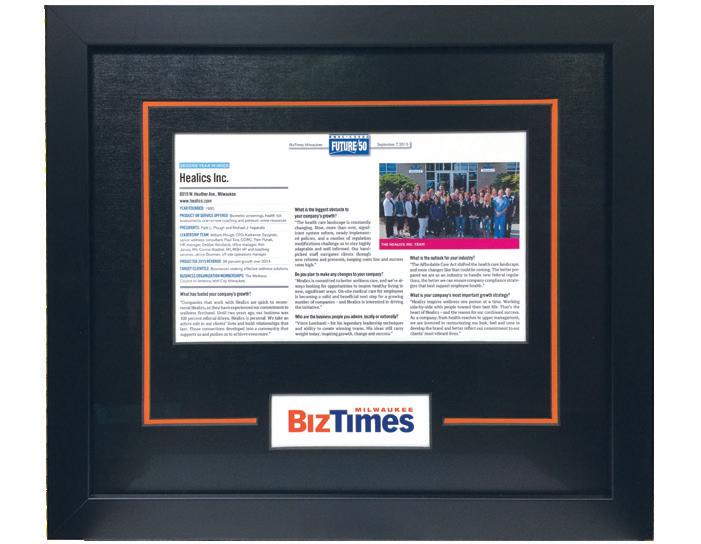
23 minute read
Strategies
BUSINESS IN RACINE & KENOSHA
CURTIS WALTZ | .AERIALSCAPES.COM
An aerial image of the Foxconn site, taken Oct. 4.
Deadlines loom for Foxconn development
BY CARA SPOTO, staff writer
WHEN THE FOXCONN development was first pitched by then Gov. Scott Walker and the company’s former chief executive officer Terry Gou, local and state leaders were promised a manufacturing metropolis off I-94 in Mount Pleasant, one that would catalyze development of a 3,000-acre tax increment financing district.
In that initial development agreement, Foxconn executives agreed to invest $10 billion to construct a 20 million-square-foot manufacturing campus and create 13,000 jobs.
Five years later, Foxconn’s 825-acre Area 1 – one of four areas in a TID that had been planned with the expectation of other manufacturers flocking to the area – consists of four buildings: a 1-million-square-foot “advanced manufacturing” facility; a 300,000-square-foot “smart manufacturing center,” a 120,000-square-foot “multipurpose building” and a 100-foot-tall “high performance computing data center globe.”
Foxconn originally planned to manufacture LCD screens at the complex, but those plans never moved forward. Recently the company has been making servers, server racks and computer motherboards at the site, according to a source and a Milwaukee Journal Sentinel report.
Under the state’s original incentive package with the company, Foxconn could have received up to $2.85 billion in tax incentives if the company created 13,000 jobs and invested $10 billion in capital expenses in the complex. After Tony Evers was elected governor, the state renegotiated its deal with the company. The new incentive package offers the company up to $80 million in tax credits if it hires 1,454 workers and invests $672 million in capital spending in the complex by the end of 2025.
But the company faces another deadline – this one involving property values that will require the Taiwanese tech giant to pay millions more in property taxes whether or not the factory complex increases in size, value or production.
Under a TID agreement between the company and the Village of Mount Pleasant, “the improvements” in Area 1 – including parking lots and buildings – must be worth roughly $1.4 billion by Jan. 1, 2024.
Right now, Foxconn is paying about $10 million on the current assessed value of the improvements in Area 1, which sits at roughly $550 million.
If that value hasn’t increased to the agreed upon $1.4 billion by the deadline, the company will still have to pay its tax bill as if the land is worth that much. Based on the village’s current tax rate, that tax bill would equal $27 million.
That $27 million tax bill would come on top of $7.3 million in special assessment payments the company is also making annually to pay back the county for property acquisition costs.
Should the company default, the village and Racine County could be faced with an inability to pay off the more than $310 million in debt the entities issued to acquire the land and make infrastructure improvements.
Faced with questions from concerned residents, officials have noted that the company has so far made all of its payments, including a $60 million contribution in 2017 and would face forfeiting its current investments as well as the potential state incentives were it to default.
They’ve also pointed to protections in the development agreement. Those protections include the village’s ability to claw back development rights on the land it owns within the TID: about 100 acres in Area 1 and 1,471 acres in Areas II and III.
The village would also seek compensation to the fullest legal extent, according to an official project fact sheet, which would include taking possession of the land and assets in the Foxconn development.
Asked to respond to ongoing concerns about the potential for Foxconn’s default and what development potential exists for the Foxconn-owned land and the more than 1,500 acres of village-owned land in the TID, Milwaukee-based Mueller Communications, which has been staffed with handling Foxconn-related media inquiries for the Village of Mount Pleasant and other entities, provided this quote from Claude Lois, the Foxconn project director for Mount Pleasant:
“Foxconn has met every financial obligation under the local contract and the village fully expects that the company will continue to do so. We continue to be well-positioned to attract future investments in Mount Pleasant’s TID #5 and are particularly hopeful that a high-tech manufacturer will develop on this attractive, shovel-ready site.” n






Keep up with BizTimes’ 2023 roundup of the leaders making a difference throughout southeast Wisconsin.
At companies across southeast Wisconsin, notable executives are running businesses, navigating company restructurings, serving on boards, running marketing departments, and investing in growth throughout the region. The notable individuals profiled in these categories are nominated by their peers at work and in the community.
NOTABLE HEROES
IN HEALTH CARE
Notable Heroes in Health Care salutes the accomplishments of people and organizations making a positive difference on the front lines of health care.
Extended Nomination Deadline: November 11, 2022
Issue Date: December 12, 2022
Look for these Notable and Rising Stars nominations in 2023!
Notable Leaders in Higher Education
Nomination deadline: December 16, 2022 Issue date: January 23, 2023
Notable Alumni
Nomination deadline: July 14, 2023 Issue date: August 21, 2023
Notable BIPOC Executives
Nomination deadline: January 13, 2023 Issue date: February 20, 2023
Rising Stars in Manufacturing
Nomination deadline: September 1, 2023 Issue date: October 9, 2023
Notable Women in STEM
Nomination deadline: February 17, 2023 Issue date: March 27, 2023
Notable Women in Insurance
Nomination deadline: September 15, 2023 Issue date: October 23, 2023
Notable Women in Construction & Design
Nomination deadline: March 10, 2023 Issue date: April 17, 2023
Notable Mortgage Brokers and Title Officers
Nomination deadline: April 7, 2023 Issue date: May 15, 2023
Notable Nonprofit Board Leaders
Nomination deadline: April 28, 2023 Issue date: June 5, 2023
Notable Veterans
Nomination deadline: September 29, 2023 Issue date: November 6, 2023
Notable Women in Hospitality
Nomination deadline: October 13, 2023 Issue date: November 20, 2023
Notable Health Care Leaders
Nomination deadline: November 3, 2023 Issue date: December 11, 2023
Notable Leaders in Accounting
Nomination deadline: June 16, 2023 Issue date: July 24, 2023
INSURANCE & BENEFITS
Inside the 25-story Ascent, a hybrid mass timber building in downtown Milwaukee.

Insuring mass timber buildings can be more complex, but cheaper
BY KATHERINE BECK, for BizTimes
WHEREVER THE EYE lands in one of newest mass timber buildings, from the floor to the ceiling, it sees wood. Wood floors. Wood beams. Even wood ceilings, as is the case at the new Ascent apartment tower on Kilbourn Avenue in downtown Milwaukee.
Relying heavily on wood for construction isn’t anything new, after all it was how buildings were constructed for centuries. But as technology improved and new building materials were invented, how buildings were constructed also changed.
However, as people rediscover the charm of exposed wood in renovated century-old buildings in Milwaukee, and across the country, new construction is also incorporating the look.
For Ann Pieper Eisenbrown, owner of Pieper Properties, primarily using wood to construct Milwaukee’s first mass timber project, Timber Lofts, was about more than aesthetics; it was about sustainability and cutting down on construction timelines.
Mass timber differs from traditional lumber construction in that it uses large pieces of timber to make large pieces for the project, such as columns, beams and floors.
Not that long ago, Pieper Eisenbrown and others wouldn’t have been allowed to erect mass timber high-rises. However, changes in the U.S. building code have allowed for such construction to happen. While mass timber construction isn’t anything new, it does present some complicating factors for insurance.
Pieper Eisenbrown said she didn’t run into any issues with getting Timber Lofts insured after taking its insurability into consideration throughout the planning and construction process. But that isn’t always the case for builders of mass timber projects, and the WoodWorks - Wood Products Council recognizes that some insurance companies are cautious about providing insurance for mass timber construction. As such, it has prepared a paper to help guide developers and owners who need insurance for their mass timber projects.
Two types of insurance are taken into consideration when discussing mass timber buildings: builder’s risk insurance for during construction and property insurance for when the building is finished and occupied.
“Relative risks are assessed differently for each, and each requires a unique approach,” according to WoodWorks. “… Construction-phase risks associated with fire are different in mass timber buildings than with most other framing systems. Since the timber elements have inherent fire-resistance capabilities, a building can have a certain level of passive fire resistance after the frame is erected. Protection doesn’t rely on (and wait for installation of) materials such as spray-applied fire proofing. The potential for faster construction can also mitigate several risks. Less time under construction means less time for potential hazards such as theft, arson, etc.”
For property insurance, factors such as moisture, durability and building enclosure detailing must all be taken into consideration, according to WoodWorks, and are usually site-specific.
Jamie Vanderveldt, a commercial insurance consultant with R&R Insurance Services in Pewaukee, said with mass timber projects remaining uncommon in the area, they have worked more with frame habitational construction for apartment buildings and the corresponding builders risk processes for those projects that have values up to $100 million.
“The difficulty in insuring a mass timber project is many insurance companies are not experienced with this type of construction and don’t have the capacity for this much risk on one project,” Vanderveldt said. “Finding the right carrier that is willing to take on the risk would be the most difficult part of the project. Especially in today’s marketplace, where carriers’ rates are increasing, construction inflation is high driving the total insured value of the project much higher than even one or two years ago. Some aspects of a mass timber project that would need to be taken into consideration when discussing insurability
— MICHAEL THOMPSON

The Ascent The Ascent

are if the product is up to code and the experience of the general contractor.
“Mass timber uses panels, and if there is a weak or damaged panel, it can cause collapse or water damage issues to the structure,” Vanderveldt said. “Another concern would be choosing an experienced general contractor with this specific experience. Because the general contractor is in charge of the whole site, the insurance companies would look for site security, heat and motion monitoring with alarms, fencing, etcetera to keep the general public off the site. Site plans, construction schedules and more are always important to any project.”
However, while one might think the cost of insuring a mass timber project would be more than a building that relies heavily on steel or concrete, in fact they are less expensive to insure. Vanderveldt said the rates for mass timber generally are about 20% to 30% less than a traditional frame project because of the quality of construction materials that have a better fire rating. Pieper Eisenbrown doesn’t have any more mass timber projects planned but does have advice for others who do when it comes to insurance: Start early with the insurance process and review the construction methods with the carriers.
Having opened in 2020, the 60-unit Timber Lofts on Florida Street in Walker’s Point was followed by Milwaukee-based New Land Enterprises’ Ascent, a 25-story apartment building that is the world’s tallest hybrid timber structure. Its 19 apartment floors are on top of a six-story concrete podium.
Joining the mass timber construction portfolio in Milwaukee would be the Edison, which is a planned 16-story apartment building along the Milwaukee River downtown, northeast of State and Edison streets. n
2022 OVATION Awards
| FORWARD AWARD WINNERS
LIFTPRO LLC
3120 64th St., Kenosha
INDUSTRY: Aerial lifts liftprowi.com

Founded in 2008, Liftpro started in a 4,000-square-foot building before moving to a 25,000-square-foot facility in 2012. The company offers a full line of aerial lifts for rent or purchase, including scissor lifts, boom lifts and push-around man lifts. Liftpro has invested more than $3.5 million in new delivery trucks, van and rental equipment and more than $400,000 in its building. The company delivers throughout southeastern Wisconsin and Chicagoland and provides service on customer-owned lifts and transportation for customer machines. In the past three years, Liftpro has more than doubled employment to 14 and its revenues have topped $6 million. Beyond its business growth, Liftpro is involved with a number of nonprofits, including the Boys & Girls Clubs of Kenosha, youth

Liftpro’s Kenosha building and college sports teams, Kenosha County Fairgrounds and many more. The company regularly donates aerial lifts and equipment to charities and other groups in need of help. Last year, donations totaled more than $50,000.
CELEBRATING KENOSHA COUNTY’S BEST IN BUSINESS
Congratulations to these dynamic companies and entrepreneurs. Let’s continue to celebrate growth throughout the Kenosha area in the next year. Thank you to our sponsors, Johnson Financial Group, the University of Wisconsin-Parkside, and M3 Insurance, and our supporting sponsors CMIT Solutions of SE Wisconsin, Darwin Realty and Development, and Gilbane Building Company, for their investment in the Kenosha-area business community. Congratulations and best wishes for much continued success!
ORDER YOUR REPRINTS!
30 / BizTimes Milwaukee OCTOBER 24, 2022
Awards, cover stories, special reports, advertisements, feature stories, whatever your interests may be. We’ll provide reprints of any published material.
9

Optimize your self-funded benefit plan with Quartz Align.
Learn how a provider-sponsored plan can help you maximize your benefit investment.
Talk to your benefits advisor or call us directly.
Calvin J. Rigsby II, CSFS®
Director, Self-Funded Sales
(608) 471-4707
QuartzBenefits.com
Administered by Quartz Health Solutions. ©2022 Quartz Health Solutions, Inc.
INSURANCE & BENEFITS
KAMES PHOTOGRAPHY
Staff wait on diners at Buttermint, the newest concept by Black Shoe Hospitality that opened late last year in Shorewood.
Restaurant operators turn to insurance and benefits as attraction, retention tool – but at a steep cost
BY MAREDITHE MEYER, staff writer
AS THE SERVICE and hospitality sector continues to face workforce challenges coming out of the COVID-19 pandemic, restaurant operators are putting in extra time – and money – to be an employer of choice.
One tactic that has gained traction, even in the years prior to the pandemic, is offering access to health insurance and benefits. But even as demand for full health care coverage has increased post-pandemic, it remains one of the most expensive investments an operator can make.
“The restaurant industry, because we deal with heat, fire, grease and knives, we run into higher pricing than what you’d find in a different industry that may be more desk-based, as an example,” said Susan Quam, executive vice president of the Wisconsin Restaurant Association.
As the need for talent recruitment and attraction has increased, so has the importance of investing in employees’ wellbeing. These days, however, in an industry where average profit margins already range from 3% to 5% percent, investing in health insurance may seem all the more unattainable.
“Right now, we’re seeing that our inflation in the restaurant industry for food and other products is twice the consumer price index, so we’re running at about 15% or 16% inflation for our goods,” said Quam. “And then you throw on a 25%30% increase of wages paid and then all of the extra costs like gas, electricity and other overhead and other insurance, so they’re having a hard time raising their menu prices high enough to cover all of those costs, and then try to add in (employee health) insurance.”
Through a partnership agreement with the National Restaurant Association, WRA has worked with Minnetonka, Minnesota-based UnitedHealthCare for nearly a decade to offer discounted health care options to its members. Those options range from employer discounts on medical rates for fully insured groups to individual and family health insurance that both full- and part-time employees can purchase on their own at a special rate.
The newest offering, Teladoc Health, was added just before the pandemic hit. Priced at $9 per employee per month, the employer-sponsored program offers unlimited access to virtual doctor visits for mental health and medical conditions for all employees (full time, part time and furloughed) and their families. The program’s mental health service particularly gained traction during the pandemic, said Quam, as employers and employees alike dealt with the stress of keeping a business afloat or making enough money to support a family.
She said Teledoc continues to be a popular “entry-level” way into the world of employee-sponsored health insurance.
“It’s a program that has a lot of promise, especially for our very small operators who don’t have a lot of employees and have a hard time trying to connect up with the full insurance,” said Quam.
WRA is also seeing operators who can’t afford full medical coverage but, as an alternative, are now offering other kinds of less-expensive insurance, such as dental, vision, disability and life.
For at least one Milwaukee-based restaurant group, a recent additional investment in employee benefits is seeing a slow return, at least on the hiring front.
Black Shoe Hospitality, which owns Buttermint, Maxie’s, Story Hill BKC and Blue’s Egg, has offered health insurance to its full-time employees for almost all of the 15 years it’s been in business, but earlier this year, in an effort to increase fulltime staffing, the company bulked up its compensation packages with dental, vision, disability and life insurance as well as 401(k) matching.
“I would love to be telling you about a success story that it’s made all the difference in recruiting people, but unfortunately it has not,” said Dan Sidner, co-owner of Black Shoe Hospitality.
Sidner says he’s proud of the group’s current base of 160 employees. But unfortunately, from an operational standpoint, the ratio of full-time to part-time staff has shifted drastically – from 65% full time to 35% part time pre-pandemic to now 45% to 55%.
And even after increased pay, additional time off, and what’s amounted to hundreds of thousands of dollars’ worth of insurance and benefits offerings, “we are not seeing the benefit of additional (job) applicants,” said Sidner.
It’s a different story for employee retention and satisfaction, however, especially for employees with families.
Sidner pointed to one example of an employee who now provides health insurance for her two children and husband, who does not receive benefits through his job. One of her children has some health issues, and with access to medical coverage through her job at Black Shoe, doctor’s visits are now less of a headache. There’s also the employee who recently had a baby and was able to have insurance cover most of the pre-natal care and hospital expenses.
Following the addition of the 401(k) match, Sidner said he got positive feedback from several managers saying the benefit was something they never expected from an employer in the restaurant industry.
“(Adding more benefits) has meant a tremendous amount to the employees we already have, especially managers, because a restaurant manager is a restaurant professional – someone who wants to make a career of it,” said Sidner. “I’m very proud to offer those benefits to a restaurant manager because we’re asking them to do everything that exists in any other professional career. … We need people who want to make a career in the hospitality industry.” n

We are proud to serve you as the only family and locally owned business media company in southeastern Wisconsin.
Buy Local

CELEBRATING 27 YEARS
Contact Linda Crawford at advertise@biztimes.com
2023 EDITORIAL CALENDAR
SEPTEMBER
Special Report Notables/Rising Stars Supplement
Advertising Section
Event
Thought Leadership Pages
Business Cares Covers
1
MAY
Workforce Issue
• Small Business Week • Franchisees • Labor & Workforce
BizExpo - May 1 Go Red for Women How To: Advice for Small Businesses
11
25
• Banking & Finance • Office Space
STUFF SE Wealth Management & Estate Planning Q&A • Future 50 Winner Profiles • Entrepreneurship & Family Business
Future 50 Awards - Sep 29
JANUARY
Economic Trends 2023 Notable Leaders in Higher Education Economic Trends Event - Jan 26
Inside the Industry
FEBRUARY
• Corporate Event Planning • Energy & Environmnent Notable BIPOC Executives
STUFF WI Hospitality & Event Planning
Education
MARCH
• M&A: Big Deals • Higher Education & Professional • Development Notable Women in STEM
M&A Forum - Mar 30
Anniversaries
17
APRIL
15
5
• Health Care • Commercial Development • Business in Waukesha County Notable Women in Construction & Design
Milwaukee County 2050
The Executive
Great Places to Work • Manufacturing • Banking & Finance Notable Mortgage Brokers & Title Officers
JUNE
19
Family Business Issue • Family Business • Business in Ozaukee, Washington and • Sheboygan Counties
Notable Nonprofit Board Leaders
Family & Closely Held Business Summit - Jun 7
Faces of Family Business
Innovation Issue Innovation, Startups, Research & Development
Leaders in Innovation
24
JULY
Mid-Year Economic Forecast Issue • Mid-Year Economic Forecast • Diversity in Business Notable Leaders in Accounting
CEO Q+A Diversity & Inclusion
21
AUGUST
Women in Business Issue • Corporate Event Planning • Women in Business OCTOBER
9
23
Manufacturing and Logistics Notable Manufacturing Executives Manufacturing Summit - Oct 5 Breast Cancer Awareness
Breast Cancer Awareness • Business in Racine & Kenosha • Insurance and Benefits
Notable Women in Insurance
KABA Ovation Awards
NOVEMBER
6
20
Community Issue • Real Estate & Development • Veterans in the Workplace Notable Veterans
Giving Guide: A Nonprofit & Philanthropy
Spotlight • Nonprofit Excellence Awards - Nov 3 • Commercial Real Estate & • Development Conference - Nov 17
Real Estate Q&A: Building Projects • Nonprofit Excellence Award Winner • Profiles • Health Care & Wellness
Notable Women in Hospitality
DECEMBER
Notable Alumni Women in Business - Aug 23 Venues: Hotels, Entertainment, Dining & Meeting Directory
How She Leads 11 • Manufacturing: Food & Beverage • Banking & Finance • Best in Business Notable Health Care Leaders
advertise@biztimes.com 7 414.336.7112 081922
Planning Ahead for 2023?
Request a copy of the 2023 editorial calendar today
• Special Reports • Thought Leadership pages • Events • Business Cares covers • Notables and Rising Stars recognition • Supplements
For more information, contact Linda Crawford at 414-336-7112 or advertise@biztimes.com

Power play
Stellar performance gives Yankees star strong position in the marketplace
SINCE THE FIRST PITCH was thrown out in April, one of the big questions in Major League Baseball has been: Will Yankees slugger Aaron Judge resign with the team, or become a free agent?
Amazingly, at the beginning of this season, Judge turned down an offer from the New York Yankees, worth $213 million for seven years.
Little did he know, this season he would break Roger Maris’ American League single-season record of 61 home runs and become a candidate for the league’s Most Valuable Player award. Judge’s market value has only risen since he turned down that huge contract offer earlier in the year.
Based on his performance, Judge is “driving the bus” when it comes to contract negotiations. Assuming he declares free agency, he will have many passengers boarding his “bus,” including the Yankees and several other teams that hope to sign him.
This should be an interesting set of negotiations.
Usually in contract negotiations the guidelines are clear. Not this time. In recent years, some of MLB’s biggest stars Mookie Betts of the Dodgers, Mike Trout of the Angels and Fernando Tatis Jr. of the Padres each signed contracts in the $300 million range.
These contracts all are above the initial offer from the Yankees to Judge and provide him with a legitimate basis for countering with an amount above the team’s initial offer. He has both information and legitimate power.
There will be plenty of other free agents watching this negotiation scenario play out on the national stage. This could become a template for future contract negotiations.
What is Judge’s true value? The Yankees need to figure it out quickly or the marketplace will do it for them. There will be a bidding war among the passengers on Judge’s bus. This will result in a monster contract, and anyone riding the bus has the ability to have skin in this game.
There is a veiled threat that Judge could end up across the East River in Queens playing for the New York Mets or on the Pacific Coast playing for the Dodgers or Giants. The pressure will be on the Yankees from their fan base, and from his fellow players to keep Judge in pinstripes.
So, if you were Judge’s agent, what criteria would you use to convince those many passengers on the bus that your client is worth a $300 million contract? Would you use the prior agreements with the current and past players? What should be the length of the agreement? Would you use his record-breaking performance this year? Is the fact that he could be chosen the MVP of the league an important factor in the negotiation?
All of these elements together would make for a powerful argument for a record-breaking salary agreement. I would expect his agent would use all the tools available to him to leverage the best possible deal for his client.
But, one final element must be taken into consideration. What does Aaron Judge want? At the present time this is a mystery and only he knows the answer.
So as the Aaron Judge bus continues its journey, one or more of the passengers will be getting on and off as the fare begins to increase. I expect the bidding to start once Judge declares himself a free agent at the end of the season. The Yankees need to act prior to this bus reaching that final stop on the journey, step up to the plate and make him the type offer he cannot refuse.
They had that opportunity at the beginning of the season and did not make their best offer. Now, it’s safe to say, at this time the ball is in Aaron’s court and he will be the ultimate judge.
This situation can easily occur in salary negotiations with top executives. Many companies base their offers on what the last person was earning, rather than researching what the going rates are in the relevant market. If this is the mid- to upper-level executive you want to add to your team, make them an offer that is more than competitive, one that satisfies their needs. More than likely, there is a high probability they are also negotiating with other companies and you want them to join your team. Make your first offer your best offer, and you will not strike out. Instead, you may hit that needed home run. n
CARY SILVERSTEIN
Cary Silverstein, MBA, is a speaker, author and consultant, a former executive for Gimbel’s Midwest and JH Collectibles, and a former professor for DeVry University’s Keller Graduate School. He can be reached at csilve1013@aol.com.


